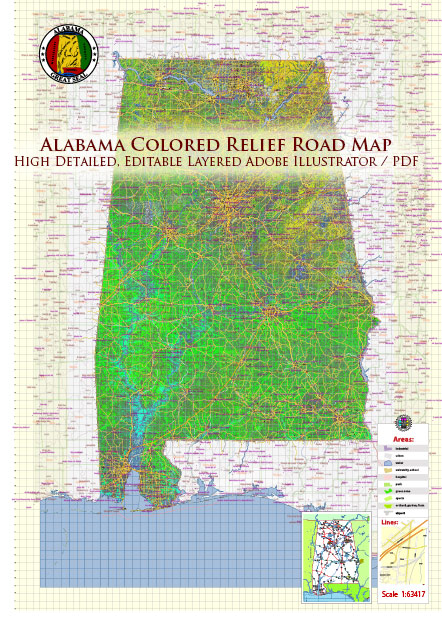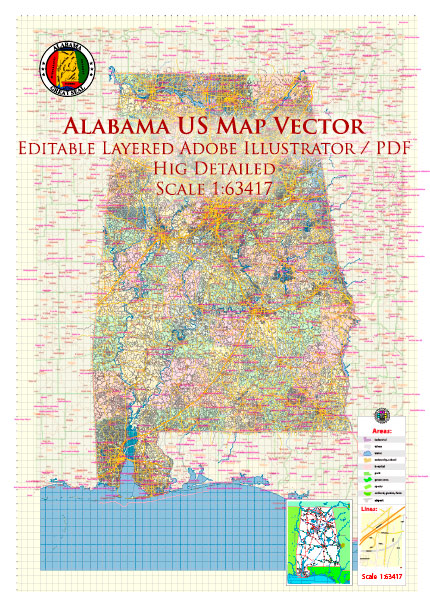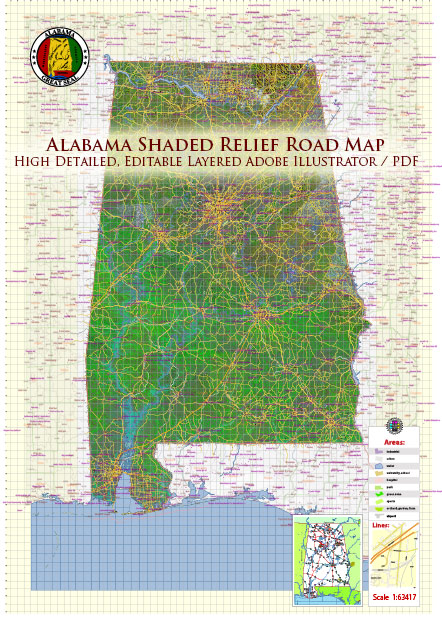Location and Geography
You are here: Home › Regional Planning Agency › Location and Geography
The Economic Development District represented by the Top of Alabama Regional Council of Governments is situated in northeast Alabama in the southern foothills of the Appalachian Mountains and the southernmost area of the Tennessee River Valley. Centered on the Huntsville Metropolitan area, it is in proximity to the larger metropolitan areas of Nashville, Chattanooga, Atlanta, Birmingham, and Memphis. The district consists of the five counties of DeKalb, Jackson, Limestone, Madison and Marshall. The total land area of the District is approximately 3,796.7 square miles. The following paragraphs contain a more detailed description of the location and geography of each of the five counties.
DeKalb County
DeKalb County covers much of the Appalachian foothills section of northeast Alabama. To its north is Jackson County and to its east is Georgia. Its western border is shared with Marshall County. South of DeKalb is Cherokee and Etowah Counties. The County stretches from the northeast to the southwest and covers a total land area of 777.9 square miles. DeKalb resides on top of Sand Mountain and is split between a western region of elevated plateau and an eastern region of mountainous ridges and canyon features. Transportation networks are more uniform and consistent in the western region to Fort Payne and Interstate 59. East of these locations Lookout Mountain has fewer and less well-connected roadways. The county seat and principal population center is Fort Payne. No major bodies of water are found in DeKalb County, but the Little River Canyon area acts in a similar fashion to that of a major river in that it prevents east to west travel except in a few locations.
Jackson County
Jackson County forms the far northeast corner of Alabama. It is entirely bordered on the north by Tennessee, on the east by Georgia, on the west by Madison County, and on the south by Marshall and DeKalb Counties. Jackson County is the seventh largest county in Alabama by land area, and has a total land area of 1,078.7 square miles. This area is divided into three physical regions. In the northwest, the Cumberland Plateau creates hilly terrain where transportation routes chiefly follow small river and creek valleys. Central to the county, the Tennessee River and floodplain cut through Jackson County in a southwesterly direction. This relatively flat terrain is the path of Jackson County’s primary transportation route, U.S. Highway 72, as well as the location of its principal population centers. Only two bridges allow access across the river to Jackson County’s third physical region. The Sand Mountain area of the county is notably elevated from the river but is flat on top. A consistent network of county roads ties the small towns of this area together.
Limestone County
Limestone County is the westernmost county in the District. To its north is the Tennessee state line and it borders Lauderdale County to the west and Madison County to the east. Lawrence and Morgan Counties form the southern boundary, sharing the Tennessee River with Limestone County. Within its boundary Limestone County has 568.1 square miles of land that tends to gently rise to the north. The county is largely covered by fertile floodplain, and this gentle terrain results in a road system dominated by long, straight routes on a north-south and east-west orientation based on early township and range lines. Only the section northwest of the Elk River varies largely from this pattern. Limestone County is roughly cut into four quadrants by its two principal roadways. Interstate 65 halves the county as it runs from north to south and US Highway 72 bisects the county as it travels from west to east towards Madison County. Four feeder roads link the county seat, Athens, with outlying communities: US Highway 31 through Tanner, State Road 99 from the Lester area, Highway 127 from Elkmont, and Highway 251 from Ardmore.
Madison County
Madison County is located in the north central portion of the District. To its north is the Tennessee state line and it borders Limestone County to the west and Jackson County to the east. Marshall and Morgan Counties form the southern boundary, sharing the Flint and Tennessee River with Madison County. Within its boundary Madison County has 804.9 square miles of land. It is mostly flat on northern and western portions of the county, while southern and eastern portions of the county contain Monte Sano Mountain, Keel Mountain, and Green Mountain. It is the only urban county in the TARCOG region. Huntsville and Madison are the largest cities in the county. The major north-south routes include US 231/US 431 dividing Huntsville in half. State Route 53 is also a major diagonal route connecting Huntsville to north-western portion of the county. Interstate 565 and US highway 72 connect the county to Interstate 65 in Limestone County. State Route 255 is also a major north-south commuting route that connects the north-central portion of the county to Redstone Arsenal.
Marshall County
Marshall County is the southernmost county in the District and is bordered by six other counties. The dominant feature within Marshall County is Lake Guntersville, the largest reservoir on the Tennessee River. Area measurements reinforce the importance of the lake as a physical feature; while Marshall County contains the smallest land area of any county in the TARCOG region, at 567.1 square miles, it holds the largest amount of water area at 56.1 square miles. Sloping terrains ring the central lake region, but in the southeast corner of the county a steep rise onto Sand Mountain tapers off to relatively flat terrain on top. This portion of the county remains geographically distinct from the areas west of Lake Guntersville. Four municipalities contain much of the county population: Arab in the southwest; Guntersville, the county seat, is placed on a peninsula in the Lake; Albertville and Boaz both extend across Sand Mountain following US Highway 431. Primary roads within the county include US Highways 231 and 431, and State Roads 75 and 79. The area with the least consistent road network is found surrounding Grant in the northern corner of Marshall County.
Source: http://tarcog.us/regional-planning-agency/location-and-geography/




 Author: Kirill Shrayber, Ph.D.
Author: Kirill Shrayber, Ph.D.